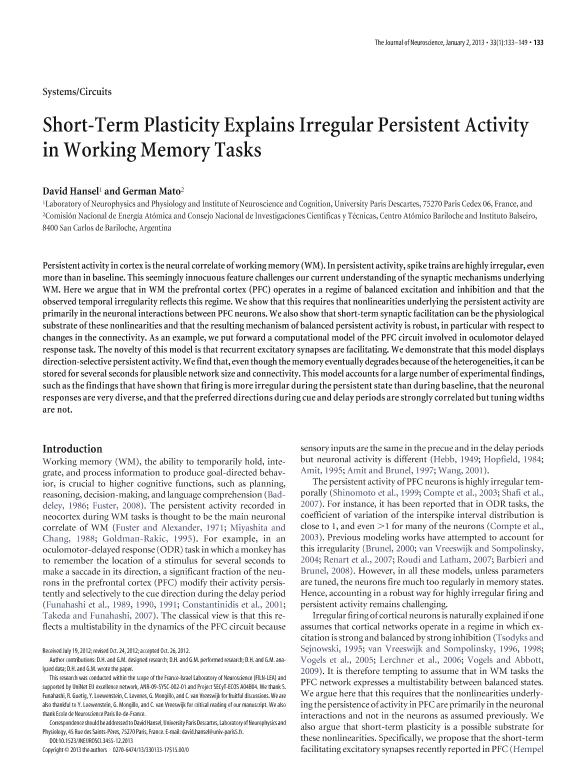Mostrar el registro sencillo del ítem
dc.contributor.author
Hansel, David
dc.contributor.author
Mato, German

dc.date.available
2016-12-20T17:11:16Z
dc.date.issued
2013-01
dc.identifier.citation
Hansel, David; Mato, German; Short-term plasticity explains irregular persistent activity in working memory tasks; Society for Neuroscience; Journal of Neuroscience; 33; 1; 1-2013; 133-149
dc.identifier.issn
0270-6474
dc.identifier.uri
http://hdl.handle.net/11336/9824
dc.description.abstract
Persistent activity in cortex is the neural correlate of working memory (WM). In persistent activity, spike trains are highly irregular, even more than in baseline. This seemingly innocuous feature challenges our current understanding of the synaptic mechanisms underlying WM. Here we argue that in WM the prefrontal cortex (PFC) operates in a regime of balanced excitation and inhibition and that the observed temporal irregularity reflects this regime. We show that this requires that nonlinearities underlying the persistent activity are primarily in the neuronal interactions between PFC neurons. We also show that short-term synaptic facilitation can be the physiological substrate of these nonlinearities and that the resulting mechanism of balanced persistent activity is robust, in particular with respect to changes in the connectivity. As an example, we put forward a computational model of the PFC circuit involved in oculomotor delayed response task. The novelty of this model is that recurrent excitatory synapses are facilitating. We demonstrate that this model displays direction-selective persistent activity. We find that, even though the memory eventually degrades because of the heterogeneities, it can be stored for several seconds for plausible network size and connectivity. This model accounts for a large number of experimental findings, such as the findings that have shown that firing is more irregular during the persistent state than during baseline, that the neuronal responses are very diverse, and that the preferred directions during cue and delay periods are strongly correlated but tuning widths are not.
dc.format
application/pdf
dc.language.iso
eng
dc.publisher
Society for Neuroscience
dc.rights
info:eu-repo/semantics/openAccess
dc.rights.uri
https://creativecommons.org/licenses/by-nc-sa/2.5/ar/
dc.subject
Memoria
dc.subject
Dinamica
dc.subject
Plasticidad
dc.subject.classification
Otras Ciencias Físicas

dc.subject.classification
Ciencias Físicas

dc.subject.classification
CIENCIAS NATURALES Y EXACTAS

dc.title
Short-term plasticity explains irregular persistent activity in working memory tasks
dc.type
info:eu-repo/semantics/article
dc.type
info:ar-repo/semantics/artículo
dc.type
info:eu-repo/semantics/publishedVersion
dc.date.updated
2016-12-19T18:19:41Z
dc.identifier.eissn
1529-2401
dc.journal.volume
33
dc.journal.number
1
dc.journal.pagination
133-149
dc.journal.pais
Estados Unidos

dc.journal.ciudad
Washington
dc.description.fil
Fil: Hansel, David. University Paris Descartes. Laboratory of Neurophysics and Physiology; Francia. University Paris Descartes. Institute of Neuroscience and Cognition; Francia
dc.description.fil
Fil: Mato, German. Comision Nacional de Energia Atomica. Gerencia del Area de Investigaciones y Aplicaciones no Nucleares. Gerencia de Fisica (CAB); Argentina. Comisión Nacional de Energía Atómica. Gerencia del Area de Energía Nuclear. Instituto Balseiro; Argentina. Consejo Nacional de Investigaciones Científicas y Técnicas; Argentina
dc.journal.title
Journal of Neuroscience

dc.relation.alternativeid
info:eu-repo/semantics/altIdentifier/url/http://www.jneurosci.org/content/33/1/133
dc.relation.alternativeid
info:eu-repo/semantics/altIdentifier/url/https://doi.org/10.1523/JNEUROSCI.3455-12.2013
Archivos asociados
